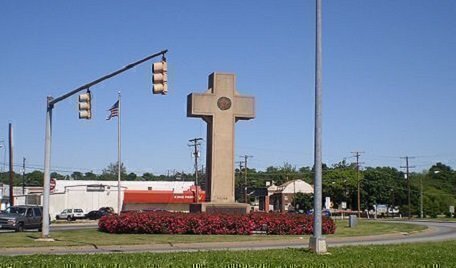A widely-splintered Supreme Court, speaking through a variety of separate opinions, on Thursday agreed to allow governments at all levels to keep long-standing religious monuments on public property. More broadly, several of the Justices strongly implied that the day may soon come when the Constitution’s ban on government “establishment of religion” will be relaxed further.
 It will take lawyers, lower-court judges, and scholars intense study to know exactly how to apply the new ruling, but one thing was immediately clear: a state government agency does not need to change, move, or take down a 40-foot-high, Christian cross that stands in the midst of a circle along a busy highway in a Maryland suburb of Washington, D.C. The monument can remain, – the Court declared, mainly because it has been in place for so long: 94 years.
It will take lawyers, lower-court judges, and scholars intense study to know exactly how to apply the new ruling, but one thing was immediately clear: a state government agency does not need to change, move, or take down a 40-foot-high, Christian cross that stands in the midst of a circle along a busy highway in a Maryland suburb of Washington, D.C. The monument can remain, – the Court declared, mainly because it has been in place for so long: 94 years.
The decision specifically protecting what is called the “Bladensburg Peace Cross” actually had the support of seven of the nine Justices. But the result has to be drawn out of a majority opinion and five separate concurring opinions. Even the majority opinion had two sections that spoke for only four Justices and, in fact, it was not clear that one of those four was clearly in agreement with the whole. The single dissenting opinion, opposed to the Peace Cross, spoke for only two Justices.
One of the most significant questions that the new ruling left in a kind of constitutional limbo is whether the Court will any longer judge government actions that affect or support religion by a standard that it has used since 1971 – amid rising criticism by conservative Justices. That is the so-called “Lemon test,” taking its name from the decision in the case of Lemon v. Kurtzmann.
Under that test, used to apply the First Amendment’s ban on government “establishment of religion,” a government activity is judged invalid if its purpose was religious in nature, if its main effect is to promote or interfere with religion, or if it “excessively entangles” the government in religious affairs. The government action cannot survive if it fails any one of those parts of the test.
In the Bladensburg monument case, the U.S. Court of Appeals for the Fourth Circuit found its continuation on public land, maintained by a state agency, to be unconstitutional based mainly on the “Lemon test.”
Overturning that result, the Supreme Court majority did not apply that test, but neither was there a clear five-Justice majority for casting that test aside entirely. Three Justices – Neil M. Gorsuch, Brett M. Kavanaugh and Clarence Thomas – argued in separate, concurring opinions that the Court had actually abandoned that test, at least for some purposes, if not entirely. Justice Samuel A. Alito, Jr., who wrote the Court’s main majority opinion, argued against its use in judging long-existing historical religious symbols on government property, but it was not clear that all six of the Justices who agreed with Alito to protect this particular monument were in full agreement on the reasoning.
Justice Stephen G. Breyer signed on to all of the Alito opinion. But he then stressed in a separate opinion that he did not understand that the new ruling would allow government to create or set up new religious symbols on public property – which the three Justices speaking most strongly against the “Lemon test” suggested. Justice Elena Kagan also supported somewhat less of the Alito majority opinion than Breyer had.
With Justice Ruth Bader Ginsburg dissenting, joined by Justice Sonia Sotomayor, and with the somewhat scattered lineup of those who wrote the majority or concurring opinions, that left only one member of the Court to be counted: Chief Justice John G. Roberts, Jr. He signed onto the Alito majority opinion, in full, without writing anything on his own or joining any of the concurring opinions.
That meant, of course, that the future of the “Lemon test” in particular and of decisions about government-religion relations very likely will depend on where the Chief Justice takes a position in follow-up cases. While supporting what Alito wrote that was critical of that test, he did not go further to express views on his own.
The historic test that Alito applied, resulting in the saving of the Bladensburg monument and other religious markers with a long history, was spelled out at length over the 31 pages of his lead opinion.
Justice Kavanaugh, in his separate opinion, summarized the new historic test this way: “If the challenged government practice is not coercive and if it (i) is rooted in history and tradition, or (ii) treats religious people, organizations, speech, or activity equally to comparable secular people, organizations, speech or activity, or (iii) represents a permissible legislative accommodation or exemption from a generally applicable law, then there ordinarily is no Establishment Clause violation.”
Justice Gorsuch, in his separate opinion that Justice Thomas joined, was sharply critical of the new history-and-tradition test, contending that it raised a whole new set of questions for judges to answer in future disputes over religious monuments and symbols on public property. Justice Thomas also wrote his own concurring opinion.
Lyle Denniston has been writing about the Supreme Court since 1958. His work has appeared here since mid-2011.







